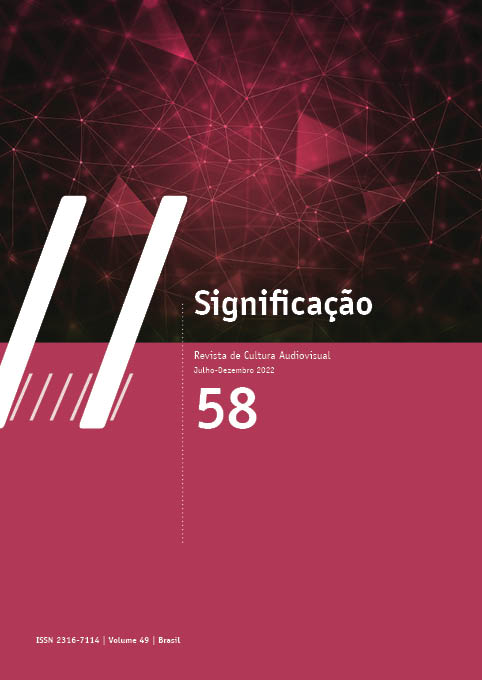How catastrophes are represented by the entertainment industry
DOI:
https://doi.org/10.11606/issn.2316-7114.sig.2022.187284Keywords:
Fiction, Catastrophe, Memory, RepresentationAbstract
This article explores happenings of wide social impact, like the tragedies caused by nuclear accidents, which have their emotional load explored by many film productions, aiming to expose the interest of the entertainment industry of exploring great worldwide tragedies. We also propose to investigate what fiction adds as appeal to the public that consumes it as an entertainment. To that end, we analyze the miniseries Chernobyl, from HBO, since, despite the spectacle traces it may show, the representation of the tragedy as a means of redemption from the past can justify the success of these types of productions, which dramatize the real catastrophe seeking to understand it. We conclude that, despite all that, this may not be the ideal genre for the scientific education of the population and for awakening their critical sense.
Downloads
References
ALEKSIÉVITCH, S. Vozes de Tchernóbil: a história oral do desastre nuclear. São Paulo: Companhia das Letras, 2016.
BADIOU, A. “El cine como experimentación filosófica”. In: YOEL, G. (org.). Pensar el cine. Buenos Aires: Manantial, 2004. p. 23-35.
BADIOU, A. Petit manuel d’inesthétique. Paris: Seuil, 1998.
COMOLLI, J. Ver e poder a inocência perdida: cinema, televisão, ficção, documentário. Tradução de Augustin de Tugny, Oswaldo Teixeira e Ruben Caixeta. Belo Horizonte: Ed. UFMG, 2008.
DELEUZE, G. Cinema 1. A imagem movimento. São Paulo: Braziliense, 1983.
FERRO, M. Cinema e História. Rio de Janeiro: Paz e Terra, 1992.
GUTFREIND, C. F. “O realismo e a catástrofe histórica nos filmes-testemunho”. Significação, São Paulo, v. 38, n. 36, p. 195-209, 2011.
NESTROVSKI, A.; SELIGMANN-SILVA, M. Catástrofe e representação. São Paulo: Escuta, 2000.
NORA, P. “Entre memória e história: a problemática dos lugares”. Projeto História, São Paulo, n. 10, p. 7-28, 1993.
OLIVEIRA, E. C. Estética da catástrofe. Goiânia: Editora da UCG, 2008.
OLIVEIRA, E. C. “O acidente com o Césio 137 e a estética do sublime”. Revista de História, Juiz de Fora, v. 37, n. 1, p. 141-165, 2013.
POLLAK, M. “Memória, esquecimento, silêncio”. Estudos Históricos, Rio de Janeiro, v. 2, n. 3, p. 3-15, 1989.
RICOEUR, P. Entre tempo e narrativa: concordância/discordância. Kriterion, Belo Horizonte, n. 125, p. 299-310, 2012.
RIVETTE, J. “De l’abjection”. Cahiers du cinema, Paris, n. 120, p. 54-55, 1961.
SELIGMANN-SILVA, M. “Violência e cinema: um olhar sobre o caso brasileiro hoje”. Comunicação & Cultura, Lisboa, n. 5, p. 95-108, 2008.
SERVALLI, M. “Minha Chernobyl e a versão HBO”. Revista Opera, [s. l.], 4 jul. 2019. Disponível em: https://bit.ly/3vkJ8dq. Acesso em: 26 abr. 2022.
SONTAG, S. Diante da dor dos outros. São Paulo: Companhia das Letras, 2003.
Downloads
Published
Issue
Section
License
Copyright (c) 2022 Maria da Conceição da Rocha Ferreira

This work is licensed under a Creative Commons Attribution-NonCommercial 4.0 International License.
Authors who publish in this journal must agree with the following terms:
- Authors keep their copyrights and grant the journal first time publication rights, having their articles simultaneously licensed under the Creative Commons Attribution License, which allows sharing texts with authorship recognition and first publication on this journal for non-commercial purposes.
- Authors are allowed to make additional contracts, for a non-exclusive distribution of the article’s version published on this journal (e.g.: publishing in institutional repositories of articles or as a book chapter), with authorship recognition and first publication on this journal.
















